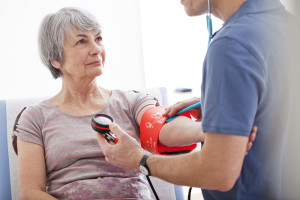Introduction
High blood pressure (called “hypertension”) is a silent killer. It is a disease, which leads to accelerated hardening of the arteries due to increased pressure in the arterial system. When the heart contracts, the blood gets pushed forward into the aorta and into all of the arteries. At the time of a heart contraction, at the top of the wave, the systolic blood pressure is measured. When the heart muscle relaxes between two beats the elasticity of the aorta maintains a certain pressure, called the diastolic blood pressure. This reading tells the doctor what the pressure is at the bottom of the wave. A normal reading for an adult, for instance, would be 120/80 (read: ” one hundred twenty over eighty” ).
With this reading “120” means 120 mm of a mercury column in the older blood pressure measuring devices, and it denotes the systolic pressure. “80” stands for 80 mm mercury and denotes the diastolic pressure. Right here I want to clear up a misconception: For many years the generally accepted medical opinion was that older people would “normally” have a higher blood pressure than younger people. This was later found to be a mistake. It turned out that the observed elevated blood pressure in many older individuals was due to the arteriosclerosis. The rigidity of the arterial walls from arteriosclerosis was responsible for the observation of the higher blood pressure in older patients. Now we are treating this with antihypertensive medication, even if it is only “isolated systolic hypertension” (meaning that the diastolic pressure is normal).
It is now generally accepted that the systolic pressure should not exceed 120 and the diastolic pressure should not exceed 80 (Ref.1). A blood pressure of 170/80 would be called “systolic hypertension“, a blood pressure of 120/90 is called “diastolic hypertension“. For practical purposes we simply will note that both of these blood pressures are abnormally elevated. Persons with these blood pressures would be considered to have high blood pressure (=hypertension) and should be treated.
Treat high blood pressure
If these patients are not treated, the consequence will be strokes, heart attacks, kidney failure, congestive heart failure and blindness. I recommend that patients measure their own blood pressure at home with a blood pressure monitor and record the findings. You can bring this record with you to the office when you see your doctor.
A lot of lives are needlessly lost because many people do not realize how important prevention is. Click on “hypertension” and choose a topic to learn more about high blood pressure.
A study dated March 2014 showed that even borderline high blood pressure can lead to a stroke and should be treated to prevent that from happening.
A Japanese study showed that vitamin E (with gamma tocopherol) can lower blood pressure to a certain extent.
References:
2. JS Trilling et al. Arch Fam Med 2000 Sep/Oct (9): 794-801.
3. DJ Hyman et al. Arch Intern Med 2000 Aug 160(15): 2281-2286.
4. CP Tifft Curr Hypertens Rep 2000 Jun (3): 243-246.
5. The Merck Manual, 7th edition, by M. H. Beers et al., Whitehouse Station, N.J., 1999. Chapter 199.
6. Noble: Textbook of Primary Care Medicine, 3rd ed.,2001, Mosby Inc.
7. Goroll: Primary Care Medicine, 4th ed., 2000, Lippincott Williams & Wilkins
8. Ferri: Ferri’s Clinical Advisor: Instant Diagnosis and Treatment, 2004 ed., Copyright © 2004 Mosby, Inc.
9. Rakel: Conn’s Current Therapy 2004, 56th ed., Copyright © 2004 Elsevie







